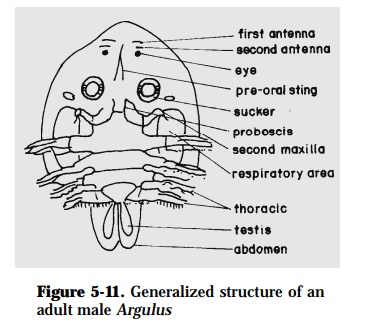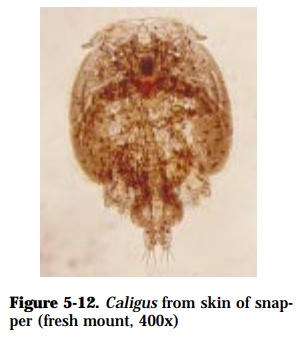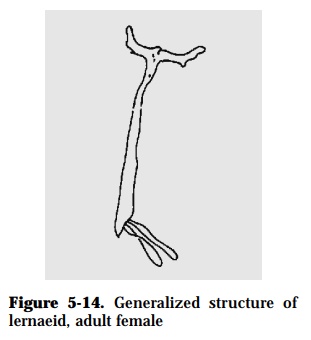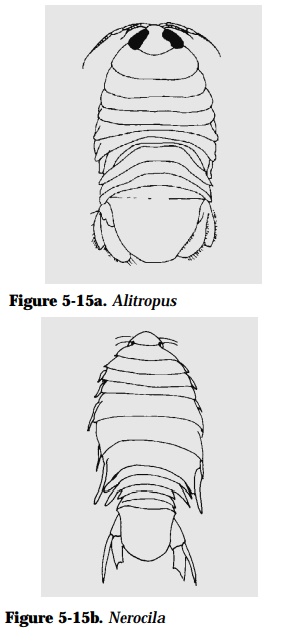Chapter: Health Management in Aquaculture: Parasitic diseases and pests
Crustacean Infestations - Fish Diseases Caused by Parasites
Crustacean Infestations
Crustacean parasites have segmented bodies covered by shell with jointed appendages.
Argulus (fish louse) infestation – female, 6-6.5 mm; male, 2-3 mm
CAUSATIVE AGENT:
Argulus (Fig. 5-11)

SPECIES AFFECTED:
Tilapia, milkfish, mullet, carp, snakehead, catfish
GROSS SIGNS:
Parasite attached to the skin, fins, buccal or opercular mucosa with two conspicuous black spots. Attachment area hemorrhagic or ulcerated.
EFFECT ON HOST:
Heavy infestation may result in mortalities. Wounds may become necrotic and ulcerated, paving the way for secondary bacterial infection.
DIAGNOSIS:
Gross and microscopic examination of host fish.
PREVENTION AND CONTROL:
• Use of filters
• 5 ppm KmnO4, 3-5 min
• 1 ppm Dipterex, 3-6 h
Caligus infestation (sea lice) – female, 3.9-5.1 mm; male, 2.85 mm
CAUSATIVE AGENTS:
Caligus epidemicus, Caligus patulus (Fig. 5-12)

SPECIES AFFECTED:
Milkfish, seabass, mullet, siganid, tilapia, snapper, spotted scat
GROSS SIGNS:
Transparent parasites appear like white patches, but are not permanently attached to the skin, fins, and gills. Infested areas have no scales, and are hemorrhagic or ulcerated.
EFFECTS ON HOST:
Infested areas are hemorrhagic. The parasite can also cause skin ulcers. Mortalities after heavy infestations have been reported.
DIAGNOSIS:
Gross and microscopic examination of scrapings from possible infested area.
PREVENTION AND CONTROL:
• Freshwater bath for 24 h
• 0.25 ppm Neguvon for 12-24 h repeated at intervals of several weeks
Ergasilid infestation
CAUSATIVE AGENT:
Ergasilus (Fig. 5-13); 0.9-1.5 mm long

SPECIES AFFECTED:
Tilapia, carp, goby, seabass, grouper, mullet
GROSS SIGNS:
Parasite attaches to the gills and body surface of the host. White to dark brown copepods, <2 mm long, some with 2 white elongated egg sacs are firmly attached to the gills. Affected fish have emaciated body.
EFFECTS ON HOST:
Destruction of the gill filaments resulting to respiratory dysfunction. Infesta-tion of 10-70 parasites per fish can lead to 50% fish loss. Secondary bacte-rial infection is common.
DIAGNOSIS:
Gross and microscopic examination of host fish.
PREVENTION AND CONTROL:
• 0.15 ppm Bromex bath for 1 week
• 0.25-0.5 ppm Dipterex bath for 24 h
Lernaeid infestation – “anchor worm”; 1.2-1.4 mm long
CAUSATIVE AGENT:
Lernaea (Fig. 5-14)

SPECIES AFFECTED:
Milkfish, carps, tilapia, snakehead, goby
GROSS SIGNS:
Parasites observed protruding from nostrils, skin, bases of fins, gills, buccal cavity. Heavy infestation can result to loss of scale and skin ulcerations.
EFFECTS ON HOST:
The skin and muscle are swollen. Ulcers may develop and result to muscle necrosis. The site of attachment may be a portal of entry for secondary microbial infection. Parasite attachment on the head may cause twisting and deformation of jaws. Affected fish suffer from serious weight loss. Mass mortality is not uncommon.
DIAGNOSIS:
Gross and microscopic examination of host fish. The body shape and at-tachment organ of the parasite have earned it its name – “anchor worm.”
PREVENTION AND CONTROL:
• 3-5% salt solution for control of larval stages
• Adult stages may be eliminated through pond drying and liming
Isopod infestation
CAUSATIVE AGENTS:
Alitropus (Fig. 5-15a), Nerocila (Fig. 5-15b); 2-3 cm long

SPECIES AFFECTED:
Tilapia, milkfish, seabass, mullet, siganid, grouper, goby
GROSS SIGNS:
The parasite attaches on the skin, mouth and gills of host fish. Clinical signs include reduced opercular movements, loss of appetite, anemia, and slow growth rate.
EFFECTS ON HOST:
The host tissue is destroyed brought about by the pressure of the parasite’s body. There is necrosis of the dermis and the gill filaments. Swimming and feeding behavior are affected. Rapid death occurs in 1-2 days particularly in young fish.
DIAGNOSIS:
Gross examination of host fish.
PREVENTION AND CONTROL:
• Mechanical removal
• 200 ppm formalin bath until parasite detaches from the host
• Drying and liming of ponds for several weeks
Related Topics